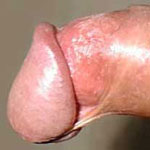What should I do if I have a tight foreskin?
If you are unable to retract your foreskin fully, especially if it becomes red or painful, you should contact your GP. If a tight foreskin has been retracted and cannot be brought forward again, you should seek urgent treatment in your local hospital
In adults, tightness of the foreskin may cause no symptoms for most of the time. Problems usually become more obvious (and troublesome) when you get an erection and attempt sexual intercourse.
What are the facts about tight foreskins?
- In most children, the foreskin cannot normally be retracted completely before the age of 5. In some, full separation may not take place until the age of 10;
- Injury or infection of the foreskin may contribute to tightening;
- Ballooning of the foreskin (blowing up when passing urine, pictured) does occur with a tight foreskin but may also occur in children with a normal foreskin;
- Tightness of the foreskin may interfere with the normal passage of urine and can, in severe cases, cause acute retention of urine; and
- Tight foreskins may encourage tumours of the penis to develop but tumours never arise in patients who have been circumcised in childhood.
What should I expect when I visit my GP?
Your GP should work through a recommended scheme of assessment for men or boys with a tight foreskin. This assessment will normally include some or all of the following:
A full history
Your GP will take a full history including whether you have had any injuries or infections of the penis at any stage. He/she will also assess the effect that the tight foreskin is having on your sexual activity.
A physical examination
 A general physical examination will be performed which will include examination of your penis and foreskin. In some patients, the problems you are experiencing may be caused by a short penile frenulum (pictured) rather than by genuine tightness of the foreskin.
A general physical examination will be performed which will include examination of your penis and foreskin. In some patients, the problems you are experiencing may be caused by a short penile frenulum (pictured) rather than by genuine tightness of the foreskin.
Additional tests
The usual tests performed are:
a. General blood tests
The actual tests performed will be left to the discretion of your GP. It is important to exclude diabetes with a blood glucose measurement. No other specific investigations are normally necessary.
b. Urine tests
Your urine will normally be tested to exclude infection and will be specifically tested for the presence of glucose (sugar).
c. Other specific tests
Your GP may take swabs from the foreskin area to send to the laboratory for bacterial culture.
What could have caused my tight foreskin?
In children, a tight foreskin is usually congenital but, in adults, it is often due to a scarring disease known as balanitis xerotica obliterans (BXO, sometimes called lichen sclerosus). We do not know the cause of BXO
What treatments are available for this problem?
If simple conservative measures fail to improve the tightness, your GP will normally recommend referral to a urologist for further advice
General measures
Stretching of a diseased foreskin is best avoided. There is no scientific evidence that it produces a cure and it can actually precipitate further tearing and scarring. This may worsen a phimosis which then requires surgical treatment later in life. Forcible retraction of the foreskin in children should be avoided.
Steroid creams may soften your foreskin if the scarring is mild; stopping the cream, however, may result in a return of the condition.
Antibiotics may be needed if swabs show any evidence of infection
Using a condom during sexual intercourse may make the penis more comfortable
Surgery
 Circumcision is the mainstay of treatment if the foreskin is scarred by balanitis xerotica obliterans. This is one of medicine's oldest operations and has often been depicted in ancient and religious art (pictured above right; by Signorelli).
Circumcision is the mainstay of treatment if the foreskin is scarred by balanitis xerotica obliterans. This is one of medicine's oldest operations and has often been depicted in ancient and religious art (pictured above right; by Signorelli).
Download a leaflet about circumcision
Preputioplasty is effective In children with congenital tightening of the foreskin. Several incisions are made into the tip of the foreskin to expose the head of the penis. The foreskin then needs to be retracted regularly until it has healed completely. Preputioplasty has a very limited role in adults and is not effective in those with a very tight foreskin due to active lichen sclerosus.
Frenuloplasty is the best option if the tightness is due to a short penile frenulum, rather than a tight foreskin. However, a short frenulum may also be associated with a some scarring of the foreskin, so full circumcision is still needed in some patients.
Download a leaflet about frenuloplasty
Partial removal of the foreskin is not recommended. Scarring may return in the foreskin remnant and the cosmetic results, particularly during erection, are often unacceptable.
Can other diseases affect the foreskin?
Urology referral is not needed for most of these conditions; they should be managed by your GP, or by referral to a dermatology or STD clinic
Yes; conditions that may affect the foreskin include:
- viral infections (genital warts, genital herpes simplex)
- bacterial infections (syphilis, chancroid)
- infestations (scabies, pediculosis)
- skin disorders (lichen planus, psoriasis, contact dermatitis, fixed drug eruptions)
- balanitis (plasma cell infiltration, Reiter's disease)
- precancerous conditions (giant genital warts, Bowen's disease, erythroplasia, Bowenoid papulosis)
- penile cancer (squamous carcinoma)
Page dated: March 2024 - Due for review: August 2026